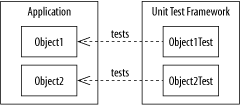| Most people who write software have at least some experience with unit testing. If you have ever written a few lines of throwaway code just to try something out, you've built a unit test. On the other end of the software spectrum, many large-scale applications have huge batteries of test cases that are repeatedly run and added to throughout the development process. Unit tests are useful at all levels of programming. What are unit test frameworks and how are they used? Simply stated, they are software tools to support writing and running unit tests, including a foundation on which to build tests and the functionality to execute the tests and report their results. They are not solely tools for testing; they can also be used as development tools on a par with preprocessors and debuggers . Unit test frameworks can contribute to almost every stage of software development, including software architecture and design, code implementation and debugging, performance optimization, and quality assurance. Unit tests usually are developed concurrently with production code, but are not built into the final software product. The relationship of unit tests to production code is shown in Figure 1-1. Figure 1-1. Production application and unit test framework 
An application is built from software objects linked together. The unit tests use the application's objects, but exist inside the unit test framework. This approach has a number of nice aspects. The production code is not cluttered up with built-in unit tests. The size of the compiled application tends to be kept smaller for the same reason. The tests can be run separately from the application, so the objects can be tested in isolation. A single unit test should test a particular behavior within the production code. Its success or failure validates a single unit of code. Well-written tests set up an environment or scenario that is independent of any other conditions, then perform a distinct action and check a definite result. These tests should avoid dependencies on the results of other tests (called test coupling ), and they should be short and simple. By starting with tests of the most basic functionality, then gradually building to tests of compound objects and behaviors, a unit test framework can be used to verify very complex architectures. Having such a test framework to build upon not only is much easier than developing standalone tests, but also produces more thorough, effective tests. A comprehensive suite of unit tests enables rapid application development, since the effects of every change can be immediately and thoroughly verified . In the traditional jargon of testing, tests are categorized as black box or white box , depending on the amount of access to the internal workings of whatever is being tested. Functional and structural tests are related ideas. For example, a test that simply runs a program and checks its return code is a black box (functional) test, since nothing is known about how the program is written. Unit tests are usually white box (structural) tests, since the test framework is able to access the internal structure of the code being tested. Most object-oriented languages provide access protection, preventing outside classes from accessing protected or private code elements. Because of this, unit tests often are written to test only the public interfaces of the objects tested. This encourages the design of objects with discrete, testable interfaces and a minimum of complex hidden behavior. Thus, writing testable objects promotes good object-oriented development practices. Another distinction is drawn between programmer and acceptance tests . Developers write programmer tests as they design and build code. These usually test low-level code elements, such as methods and interfaces. Acceptance tests may be specified or written by a nonprogrammer, such as a quality-assurance person or product manager. These generally are functional tests of high-level behavior, such as producing output or performing a user task. Unit tests may fall into either of these categories. |